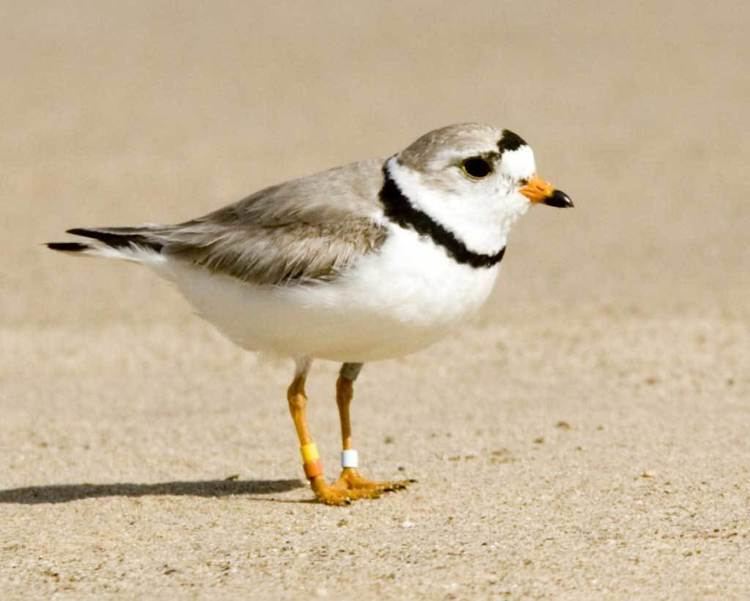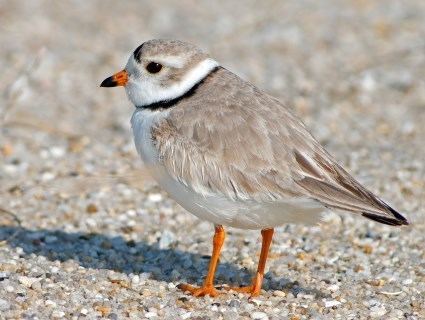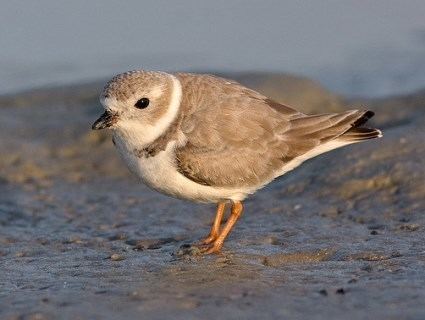Higher classification Charadrius | Phylum Chordata Scientific name Charadrius melodus Rank Species | |
 | ||
Similar Bird, Plover, Least Tern, Charadrius, Semipalmated plover | ||
Piping plovers plymouth beach
The piping plover (Charadrius melodus) is a small sand-colored, sparrow-sized shorebird that nests and feeds along coastal sand and gravel beaches in North America. The adult has yellow-orange legs, a black band across the forehead from eye to eye, and a black stripe running along the breast line. This chest band is usually thicker in males during the breeding season, and it is the only reliable way to tell the sexes apart. The bird is difficult to see when it is standing still, as it blends well with open, sandy beach habitats. It typically runs in short spurts and stops.
Contents
- Piping plovers plymouth beach
- Piping plover calls
- Description
- Subspecies
- Vocalizations
- Habitat
- Migration and breeding
- Behavior
- Status
- Historical and current conservation
- References

There are two subspecies of piping plovers: the eastern population is known as Charadrius melodus melodus and the mid-west population is known as C. m. circumcinctus. The bird's name is derived from its plaintive bell-like whistles which are often heard before the bird is visible.

Total population is currently estimated at about 6,510 individuals. A preliminary estimate showed 3,350 birds in 2003 on the Atlantic Coast alone, 52% of the total. The population has been increasing since 1999.

Their breeding habitat includes beaches and sand flats on the Atlantic coast, the shores of the Great Lakes, and in the mid-west of Canada and the United States. They nest on sandy or gravel beaches or shoals. These shorebirds forage for food on beaches, usually by sight, moving across the beaches in short bursts. Generally, piping plovers will forage for food around the high tide wrack zone and along the water's edge. They eat mainly insects, marine worms, and crustaceans.

Piping plover calls
Description

The piping plover is a stout bird with a large rounded head, a short thick neck, and a stubby bill. It is a sand-colored, dull gray/khaki, sparrow-sized shorebird. The adult has yellow-orange legs, a black band across the forehead from eye to eye, and a black ring around the neck during the breeding season. During nonbreeding season, the black bands become less pronounced. Its bill is orange with a black tip. It ranges from 15–19 cm (5.9–7.5 in) in length, with a wingspan of 35–41 cm (14–16 in) and a mass of 42–64 g (1.5–2.3 oz).
Subspecies

Two subspecies are recognized, including nominate C. m. melodus of the Atlantic Coast and C. m. circumcinctus of the Great Plains. On average, circumcinctus is darker overall with more contrastingly dark cheeks and lores. Breeding male circumcinctuses show more extensive black on forehead and bill-base and more often shows complete breast-bands. Some overlap exists.
Vocalizations
The piping plover's light call is a soft, whistled peep peep given by standing and flying birds. Its frequently heard alarm call is a soft pee-werp, which the second syllable lower pitched.
Habitat
The piping plover lives the majority of its life on open sandy beaches or rocky shores, often in high, dry sections away from water. They can be found on the Atlantic Coast of the U.S. and Canada on the ocean or bay beaches and on the Great Lakes shores. It builds its nests higher on the shore near beach grass and other objects. It is very rare to see a piping plover anywhere outside of sand or rocky beaches/shores while not migrating. Piping plovers are often found to migrate south to The Bahamas during winter months.
Migration and breeding
Piping plovers migrate from their northern range in the summer to the south in the winter months, migrating to the Gulf of Mexico, the southern Atlantic coast of the United States and the Caribbean. They begin migrating north beginning in mid-March. Their breeding grounds extend from southern Newfoundland south to the northern parts of South Carolina. They begin mating and nesting on the beach in mid-April.
Males will begin claiming territories and pairing up in late March. When pairs are formed, the male begins digging out several scrapes (nests) along the high shore near the beach-grass line. The males also perform elaborate courtship ceremonies, including stone tossing and courtship flights featuring repeated dives. Scrapes, small depressions in the sand dug by kicking the sand, are often in the same area that least terns choose to colonize. Females will sit and evaluate the scrapes, then choose a good scrape and decorate the nest with shells and debris to camouflage it. Once a scrape is seen as sufficient, the female will allow the male to copulate with her. The male begins a mating ritual of standing upright and "marching" towards the female, puffing himself up and quickly stomping his legs. If the female had seen the scrape as adequate, she will allow the male to stand on her back and copulation occurs within a few minutes.
Most first-time nest attempts in each breeding season are four-egg nests which appear as early as mid-to-late April. Females lay one egg every other day. Second, third and sometimes fourth nesting attempts may have only three or two eggs. Incubation of the nest is shared by both the male and the female. Incubation is generally 27 days and eggs usually all hatch on the same day.
After chicks hatch, they are able to feed within hours. The adults' role is then to protect them from the elements by brooding them. They also alert them to any danger. Like many other species of plovers, adult piping plovers will often feign a "broken wing display", drawing attention to themselves and away from the chicks when a predator may be threatening the chicks' safety. The broken wing display is also used during the nesting period to distract predators from the nest. A major defense mechanism of the chicks is their ability to blend in with the sand. It takes about 30 days before chicks achieve flight capability. They must be able to fly at least 50 yd (46 m) before they can be considered fledglings.
To protect the nests from predators during incubation, many conservationists use exclosures, such as round turkey-wire cages with screened tops. These allow the adults to move in and out but stop predators from getting to the eggs. After the chicks hatch, many areas will put up snow fencing to restrict driving and pets for the safety of the chicks. Threats to nests include crows, cats, raccoons, and foxes, among others. Exclosures are not always used, as they occasionally draw more attention to the nest than would occur without the exclosure. Natural hazards to eggs or chicks include storms, high winds, and abnormal high tides; human disturbances can cause the abandonment of nests and chicks as well. It is best to stay away from any bird that appears distressed to prevent any unintended consequences.
Migration south begins in August for some adults and fledglings, and by mid-September most piping plovers have headed south for winter.
Behavior
Inconspicuous birds of dry sandy beaches, plovers breed in open sand, gravel, or shell-strewn beaches and alkali flats. Each nest site is typically near small clumps of grass, drift, or other windbreak. In winter, these birds prefer sand beaches and mudflats. Migrants are seldom seen inland, but occasionally show up at lake shores, river bars, or alkali flats. Individuals forage visually in typical plover fashion, employing a run-stop-scan technique. Plovers capture prey by leaning forward and picking at surfaces; they also employ a "foot-tremble" feeding method, causing prey to move and become more conspicuous. Feeding by day and night, they eat a wide variety of aquatic marine worms, insects, mollusks, and crustaceans. Seldom found in large numbers except at a few favored wintering or staging sites where numbers sometimes reach 100 or more, plovers are more typically seen in pairs or in groups of three or four. When approached, they more often run than fly. Plovers are very aggressive when nesting.
Status
The piping plover is globally threatened and endangered; it is uncommon and local within its range, and has been listed by the United States as "endangered" in the Great Lakes region and "threatened" in the remainder of its breeding range. While it is federally threatened, the piping plover has been listed as state endangered in Illinois, Indiana, Maine, Michigan, Minnesota, Nebraska, New Hampshire, New York, New Jersey, Ohio, Pennsylvania, and Wisconsin. The Parker River Refuge on Plum Island, Massachusetts is a national network of lands and rivers dedicated to the safety of its native wildlife and specifically the Piping Plover. Protecting the Piper with full beach closures, the Refuge now "has the second largest plover population on the North Shore".
In eastern Canada, the piping plover is found only on coastal beaches. In 1985, it was declared an endangered species by the Committee on the Status of Endangered Wildlife in Canada. A large population in Ontario has disappeared entirely. In 2008, however, piping plover nests were found at Wasaga Beach and near Sauble Beach, Ontario, along the Ontario Great Lakes shores. There is also some evidence of nesting at other sites in Ontario, including Port Elgin, Ontario in 2014.
Historical and current conservation
In the 19th century and early 20th century, the piping plover was utilized for its feathers, as were many other birds at the time, as decorations for women's hats. These decorations, called plumes, became a symbol of high society, especially those from larger rare birds. This practice led to its initial population decline. The Migratory Bird Treaty Act of 1918 helped the population recover through the 1930s. The second decline in the piping plover's population and range has been attributed to increased development, shoreline stabilization efforts, habitat loss and human activity near nesting sites in the decades following World War II. The Great Lakes populations eventually shrank to only around two dozen.
Critical nesting habitats are now being protected to help the population during its breeding season. Populations have seen significant increases since the protection programs began, but the species remains in serious danger. Current conservation strategies include identification and preservation of known nesting sites; public education; limiting or preventing pedestrian and/or off-road vehicle (ORV) traffic near nests and hatched chicks; limiting predation of free-ranging cats, dogs and other pets on breeding pairs, eggs and chicks; and removal of foxes, raccoons, skunks, and other predators.
In coastal areas such as Plymouth, Cape Cod, Long Island, Sandy Hook, Cape Henlopen State Park in Delaware, North Manitou Island in Lake Michigan, and most recently, Cape Hatteras National Seashore on the Outer Banks of North Carolina, beach access to pedestrians and ORVs has been limited to protect piping plovers and their chicks at critical times of the breeding season.
